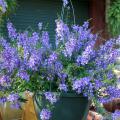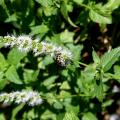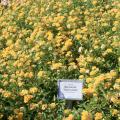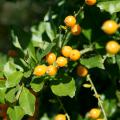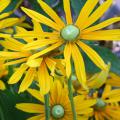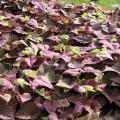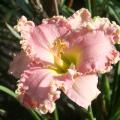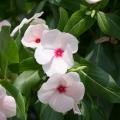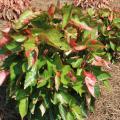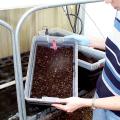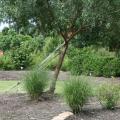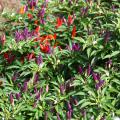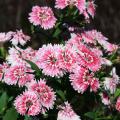Southern Gardening from 2012
If you’re looking for a little tropical flair for your home garden or landscape, consider bringing in some bougainvillea. This plant is especially gorgeous when displayed in a hanging basket that shows off its many flowers with almost iridescent colors.
If you’re one of the many gardeners who consider Angelonia an ideal plant for the hot summer garden, I would have to agree with you.
Angelonia is a member of the snapdragon family, and it is actually called summer snapdragon. Few, if any, insects or diseases bother the Angelonia in the garden or landscape. Because it thrives in the full sun during the heat and humidity of summer, it makes a wonderful addition to our Mississippi gardens and landscapes.
Mint is one of those plants that gardeners both love and hate at the same time.
Many gardeners love the sweet fragrance they smell when they brush against the mint foliage. They also find mint iced tea to be delicious or a mint julep to be a sure-fire summer time refreshment.
But in the landscape, mint grows aggressively and can quickly take over an area. I’ve heard people say -- hopefully in jest -- that the only way to control mint in the landscape is to move.
Yellow is a cheerful color that mixes and matches well in summer gardens. If your garden needs this versatile color, try Coreopsis, a tough group of plants that provides beautiful yellow and golden flowers from early summer to well into fall.
When the Mississippi summer really heats up, lantana is one of my go-to plants. Lantana is a brilliant plant that provides consistently bright colors and nonstop blooming through the summer into fall.
While many of the older lantana selections are large landscape plants, I really like the newer selections that have a smaller growth potential. These smaller plants open up entirely new growing options.
A native of the tropical regions of the Caribbean and Central and South America, the Duranta is sure to generate interest in your landscape.
Duranta is commonly called pigeon berry, and it has an arching growth habit with bluish flowers. It produces golden fruit that can feed our feathered friends.
The native plant can reach small-tree status, growing up to 25 feet tall. That’s too large for many of our Mississippi gardens and landscapes.
The black-eyed Susan is one of the most popular flowers in Mississippi and a favorite with almost every gardener. Even people who don’t know their flowers can often identify the black-eyed Susan.
The flowers are bright yellows to gold, each with a dark button cone in the center. In some selections, the centers of the petals are red, orange or maroon.
Shade is an asset during summer’s triple-digit temperatures, but you may find a shady spot in the landscape that needs some color.
If you have shade that is more dark than inviting, consider growing caladium. Caladium should be at the top of your list of shade-loving plants.
Caladiums are tropical foliage plants, native to the Amazon basin of Brazil. These plants are also right at home in our Mississippi gardens and landscapes. They are perfect for planting in front of the green background of foundation shrubs.
If you’re looking for a vigorous and unique ground cover for your landscape, consider a popular ornamental that I really enjoy, the colorful sweet potato vine.
Longtime favorites include Margarita, which is lime green with large leaves; Blackie, a cut-leaf variety with dark purple to black foliage; and Tricolor, which has leaves of green, pink and white.
New selections have introduced amazing color selections and leaf shapes.
Daylilies are extremely easy-to-grow flowering perennials, and their variety gives gardeners plenty of ways to create unique, colorful landscape designs.
The summer months certainly take a toll on most gardeners. The heat and humidity can make even the most dedicated gardener decide to stay inside for the duration. As I considered going out in the 100-degree-plus heat index the other day, I was reminded of the difference between a gardener and a “yardener.”
By the time August arrives, everyone wants to find a durable, colorful plant, and one of my favorites is the annual flowering vinca.
Annual flowering vinca has dark green, glossy foliage with a prominent rib in the middle. The foliage color makes a great background for the outstanding flower colors. These colors range from white to dark red, some with dark or white eyes. Botanically speaking, annual flowering vinca is Catharanthus rosea, but some garden centers may label it Madagascar periwinkle.
Summer’s heat can be pretty hard on flowering annual and perennial plants, but colorful foliage plants can fill in those gaps in the landscape and containers.
Foliage plants provide color without relying on flowers, so you don’t have to wait for the show to begin. Plants with colorful foliage are attractive the moment they are transplanted into your landscape.
Foliage standbys in the landscape are caladium, ginger and cannas, but there are lots of other choices. One colorful foliage plant that is underused in our Mississippi landscapes is the copperleaf plant.
One of the final gifts a productive garden can give us is raw materials to compost for use in the next year’s garden.
As we move into autumn, many of us will be cleaning up the garden, pruning and getting rid of leaves. A lot of this yard trash will end up at the curb for the city to pick up. Some of this will be chipped and composted for municipal use. The rest probably will end up in the landfill, which is not ideal.
Last week I highlighted the benefits of making and using compost in the garden and landscape. This week I’m explaining how and why you should use vermicompost. That’s right; I’m talking about worms.
Vermicomposting is a common activity at many of our elementary schools, and the kids generally enjoy participating. Students do it to learn the science of the process. As adults, we use vermicompost to enhance our garden soils and plant growth.
Hurricane Isaac’s recent visit reminds us that weather can play havoc with our landscapes. While flooding is a problem in some areas, most of the damage tends to happen to trees in the landscape.
Trees can fall or be uprooted and can have broken and torn limbs, wounds, split branches and exposed roots. In many cases, damaged trees must be removed.
You may have heard me talk over the last couple of years about my interest in using ornamental peppers in Mississippi landscapes. That’s because I am a true “chili head.”
I have a passion for hot peppers. Besides the culinary heat many of these hot peppers bring, they are colorful and have great potential for use in the landscape. There are many to choose from: some are big, others small; some come with green foliage, while others have purple; many offer multicolored fruit.
Using ornamental peppers can be unique way to add interest to your garden.
As we move into fall I’ve been paying attention to the combination containers that have looked so good through the summer months. Many of the flowering plants have started to fade. Colorful foliage plants can now transition from supporting roles to the stars of the containers.
One foliage plant in particular has been a standout lately. Persian shield, which is known botanically as Stobilanthes dyerianus, is typically considered a houseplant. But when added to a combination container, it has a lot of potential as a landscape plant.
For more than 30 years, those interested in home horticulture have been found at two events in early October that showcase landscapes and gardens.
The back-to-back events are sponsored by the Mississippi State University Extension Service and the Mississippi Agricultural and Forestry Experiment Station (MAFES). The 39th annual Ornamental Horticulture Field Day is Oct. 4 at the South Mississippi Branch Station in Poplarville. The 34th annual Fall Flower and Garden Fest is Oct. 5 and 6 at MSU’s Truck Crops Experiment Station in Crystal Springs.
Gardeners getting ready for fall planting should consider dianthus, a versatile group of plants that grow well in Mississippi gardens and landscapes.
Dianthus come in annual and perennial selections. There are cool season and warm season varieties. I really like their color palette – we can grow a wide variety of pinks, purples and whites, along with bicolors. Dianthus is one flower that lets us keep a sense of landscape and garden color continuity across all the seasons.


